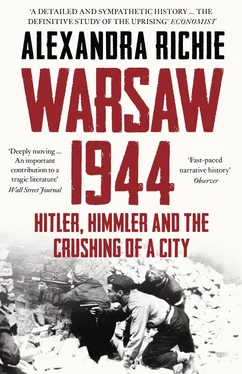Fegelein’s influence on the uprising came about in part because of his skill as a horseman. Before the war he had competed in a number of events on the international circuit, and had even created the equestrian facilities for the 1936 Berlin Olympic Games. One of his long-time competitors, and a man he admired, was a Polish cavalry officer named Count Tadeusz Komorowski, who trained the Polish eventing team which won a silver medal at the Olympics. What Fegelein did not know was that Brigadier-General Bór-Komorowski, as he was now known (‘Bór’ being his wartime code-name), had, a few months before the lavish wedding party, been appointed commander of the Polish Home Army based in Warsaw. Even as the SS cavalry officer was quaffing champagne and flirting with Eva Braun, General Bór was planning the uprising that would link the two men once again.
The day after the wedding, on 4 June 1944, Field Marshal Erwin Rommel, on his way to his holiday home, talked to Hitler about the expected Allied invasion of France. Rommel agreed with Hitler that the Allies were most likely to strike at the Pas de Calais, and reminded him that the most important thing was that they must not be allowed to establish a bridgehead on the coast. Hitler was confident that any invasion in the heavily fortified and well-defended area could be easily repulsed. Which is why, when German sentries looked out over the grey waters of the English Channel two days later, they could hardly believe their eyes. The first of 1,200 warships were slowly coming towards them, but they were not heading to the Pas de Calais. They were on their way to Normandy.
Hitler, as was his custom, had taken a cocktail of sleeping pills the previous night, and did not wake up until midday. ‘The Führer always gets the latest news after he has had his breakfast,’ the duty adjutant snapped at an impatient Albert Speer. When he finally emerged, Hitler, still in his dressing gown, listened calmly as Rear Admiral Karl-Jesco von Puttkamer told him that a number of major landings had taken place between Cherbourg and Le Havre; more were expected. Hitler sent for the head of the armed forces, Field Marshal Wilhelm Keitel, and his deputy Colonel General Alfred Jodl, but all three agreed that this was a diversion, and nothing more than an Allied trick. Hitler opted to do nothing.
Colonel Hans von Luck, head of Kampfgruppe von Luck, was in the thick of the fighting on the coast, and desperately trying to inform his superiors that he was witnessing an invasion on an unimaginable scale. ‘We were dismayed and angry that we had not been believed by the highest authority. And even by evening the Panzer divisions and reserve units stationed in the Pas de Calais were not to be withdrawn, on express orders from Hitler.’ At 4.55 p.m. Hitler revealed his complete lack of understanding of the situation by giving the extraordinary order that the Allies’ bridgehead was ‘to be annihilated by the evening’. Perversely, he seemed almost relieved by the invasion: ‘When they were in Britain we could not get at them. Now we have them where we can destroy them.’ Later, Keitel admitted his mistake: ‘If we had fully believed our radio intelligence interception we would not only have had the date of the invasion, we would even have had the exact time.’ When Hitler and his generals finally realized their error it was, as von Luck put it, ‘too late, much too late!’ 2
A furious Rommel met Hitler on 17 June in the gigantic concrete bunker near Soissons, in northern France, that had been designated the Führer’s western HQ. By now over 600,000 Allied troops had landed in Normandy. Rommel was critical of Hitler’s tactics, complaining, ‘The battle is hopeless!’ ‘Just take care of your invasion front,’ Hitler snarled in reply. ‘I shall take care of the future of the war.’ Thereafter, Rommel began to criticize Hitler openly, and lent his support to the 20 July plotters who were planning to assassinate the Führer. When Hitler discovered his treachery, Rommel, who was idolized by the German people, was given the opportunity to commit suicide rather than face a public show trial that would have resulted not only in his own death but also in the persecution of his family. Rommel chose suicide. Keitel revealed the truth about Rommel’s supposed ‘heart attack’ only after the war. 3
The Normandy landings shocked the Germans, but the news was received with jubilation in occupied Europe. Warsaw was abuzz with rumour and speculation. The success of the western attack meant, quite simply, that the war was coming to an end. The landings also came as a great relief to Stalin. Germany was now forced to fight on two fronts, and would have to divert resources away from the east. But, as ever, Stalin’s reasons were not purely military. The pathologically suspicious dictator had feared that, despite Roosevelt and Churchill’s assurances at the Tehran Conference in November 1943, they might actually invade Europe through the Balkans rather than France. Now he could remain true to the promise he had made to the British and American leaders: ‘The summer offensive of the Soviet troops to be launched in keeping with the agreement reached at the Tehran Conference will begin in mid-June in one of the vital sectors of the Front,’ he wrote. Stalin was careful not to mention exactly where the attack would take place, but he had already chosen his target. The Red Army was going to attack the German Army Group Centre, in Byelorussia.
When Oskar Dirlewanger, the leader of one of the most notorious SS units in the war, was asked why he was behaving in such a brutal fashion in Warsaw in August 1944, he laughed. ‘This is nothing,’ he said proudly. ‘You should have seen what we did in Byelorussia!’ 4He was right: the people of Byelorussia endured one of the most cruel and murderous occupations of the Second World War. The number of victims, particularly helpless civilians, is staggering. Nine million people lived in Soviet Byelorussia when the Germans invaded Russia in 1941, and two million of them, at the very least, were killed – by shooting, gassing, hanging, burning, drowning. A further two million were deported to the Reich as forced labour. Although there were exceptions, most were treated little better than livestock. On 21 August 1942 Hitler told the Nazi racial theorist Achim Gercke: ‘[Fritz] Sauckel [head of the deployment of forced and slave labour] told me a very curious fact. All the girls whom we bring back from the eastern territories are medically examined, and 25 per cent of them are found to be virgins.’ 5
The Germans killed civilians in 5,295 different locations in Soviet Byelorussia, with many villages being burned to the ground. The victims included around 700,000 prisoners of war, 500,000 Jews and 320,000 ‘partisans’ or ‘bandits’, the vast majority of whom were unarmed civilians. The Germans deliberately mixed these groups together, killing Jews under the guise of the ‘anti-bandit’ war, or murdering peasants accused of ‘helping Jews and partisans’. One German commander admitted that ‘the bandits and Jews burned in houses and bunkers were not counted’. The victims were slaughtered with pitiless cruelty, and those not murdered outright often died as the result of cold, disease or starvation brought about by the German scorched-earth policy and the creation of ‘dead zones’, in which all living things, including people, were to be destroyed on sight.
The men who directed and oversaw the mass murder in Byelorussia included Erich von dem Bach-Zelewski, Oskar Dirlewanger and Bronisław Kaminski. Although they subsequently became best-known for their roles in the Warsaw Uprising, they learned their skills long before the summer of 1944. Indeed, in order to understand what happened in Warsaw one has first to look at the history of the killing fields of Byelorussia. It was precisely because Operation ‘Bagration’, the Soviet invasion of Byelorussia, was so rapid and successful in the summer of 1944 that so many of these hardened murderers were uprooted and suddenly available when Hitler and Himmler decided to put down the ‘ Schweinerei ’ in the Polish capital. In that sense the Warsaw Uprising became an extension of the policies that had been carried out in Byelorussia between 1941 and the summer of 1944. The personnel and the methods were the same; only the location had changed.
Читать дальше





![Traudl Junge - Hitler's Last Secretary - A Firsthand Account of Life with Hitler [aka Until the Final Hour]](/books/416681/traudl-junge-hitler-s-last-secretary-a-firsthand-thumb.webp)






